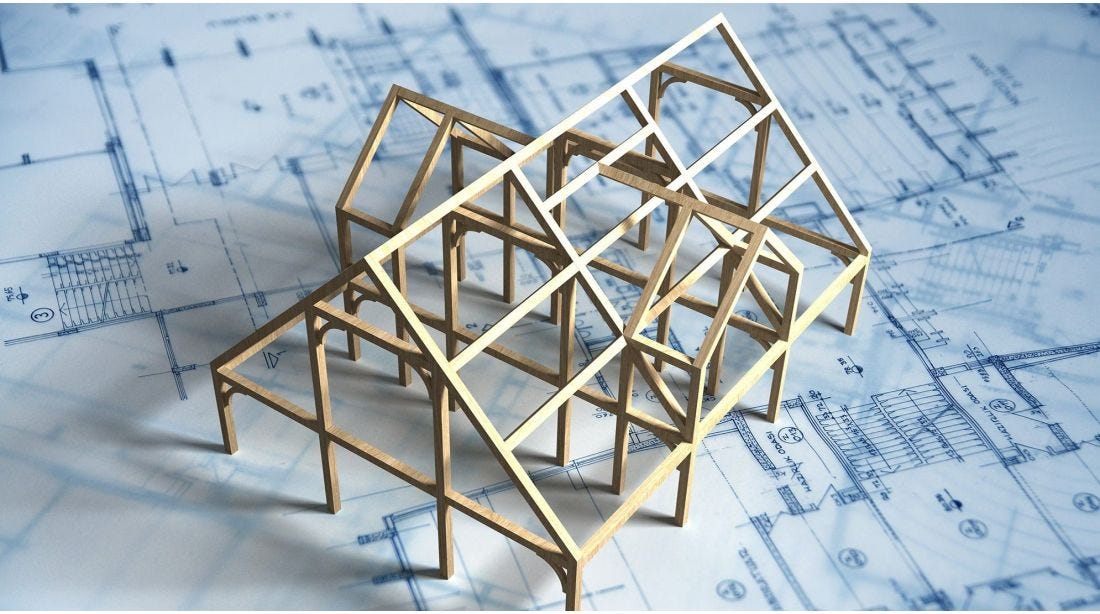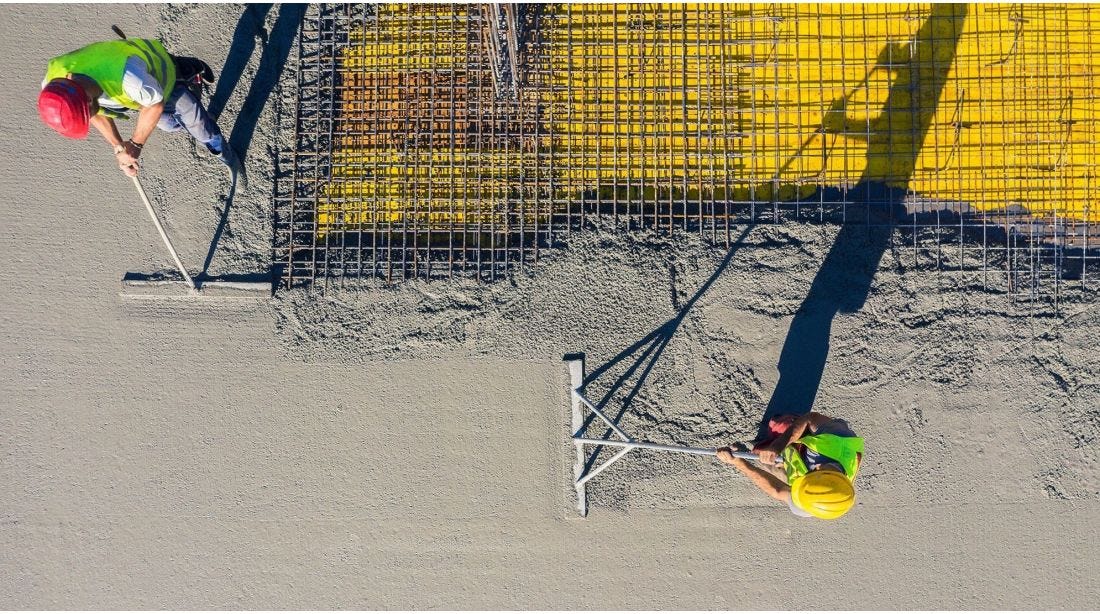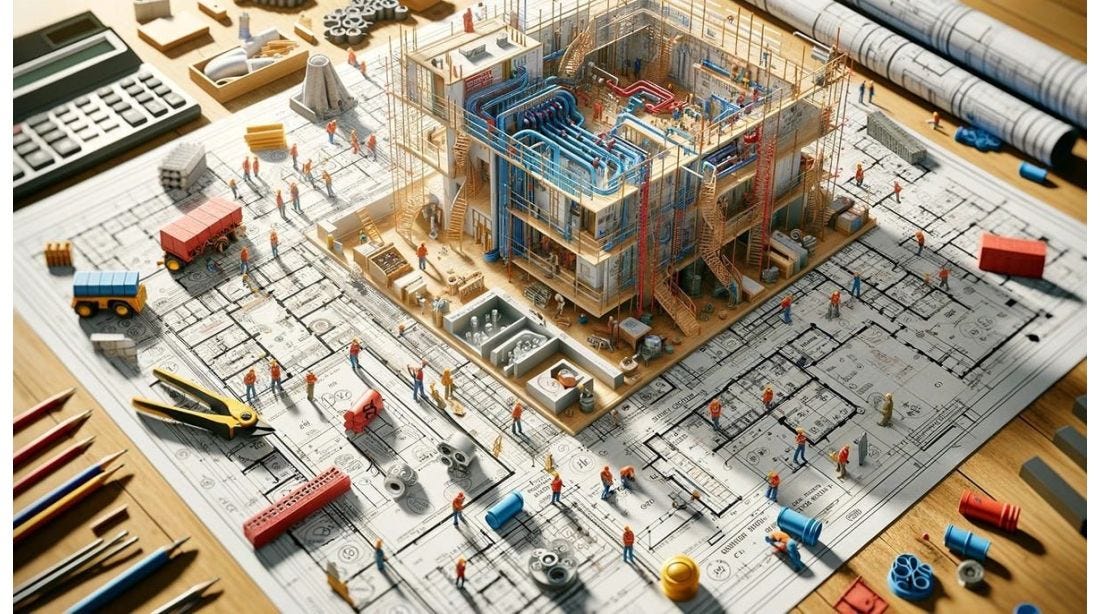In the world of construction, success relies on the careful planning and preparation that occurs before the first brick is laid — a stage known as preconstruction. It's during this phase that projects begin to take shape, laying the foundation for successful projects through meticulous planning.
In this essential guide, we'll unlock the secrets of preconstruction, the foundation behind every successful building project. We'll highlight key activities, deliverables and phases of a construction project, equipping you with the knowledge to optimize this crucial process and ensure success.
Preconstruction Checklist
Here's an overview of key tasks during the preconstruction phase. We'll explore these in further detail later on:
What is Preconstruction?
Preconstruction is the phase before physical construction begins. It bridges the gap between the initial design and the physical act of building. This crucial stage allows the project team — owner, architect, engineer and contractor — to collaboratively map out the entire journey, from initial sketches to the finished structure.
During preconstruction, the team refines the design, ensuring it is practical and meets building codes. They proactively tackle potential hurdles like unexpected soil conditions and establish a realistic budget and timeline. It's also where they select the right builder and finalize contracts.
Through meticulous planning during preconstruction, the project team mitigates various risks, disruptions and change orders in later stages. This phase not only lays the foundation for physical implementation but also ensures a full understanding of the project’s cost, scope and schedule, setting the stage for optimal outcomes.
Understanding Key Activities in the Preconstruction Process
Understanding Key Activities in the Preconstruction Process
Within preconstruction, there are a series of pivotal stages and activities that transform the ultimate vision into a detailed outline, paving the way for effective construction execution. Explore some of the critical tasks that occur during this strategic planning phase.
Project Initiation
Project initiation lays the groundwork for a successful project by defining its scope and goals.
Key Activity: Project Kickoff Meeting
The project kickoff meeting serves as the official start of the project and brings together key stakeholders to align project objectives, responsibilities and expectations. It provides an opportunity to establish rapport, build team cohesion and clarify project scope, deliverables and timelines. Additionally, the kickoff meeting may involve reviewing goals, identifying potential risks and outlining communication protocols to ensure effective collaboration.
Feasibility Assessment
During the feasibility assessment phase, stakeholders evaluate the viability of the project. Additionally, they may conduct market research to gauge potential demand and assess the project's alignment with current trends and needs within the industry or community.
Key Activity: Feasibility Studies
Before any project moves forward, it's essential to determine its feasibility, or in other words, its potential for success. This involves a comprehensive assessment of various factors such as site conditions, regulatory requirements, market demand and financial viability. Financial viability considers construction costs, ongoing maintenance expenses and potential return on investment.
Feasibility studies equip stakeholders with the information they need to make informed decisions about whether to proceed with a project and what adjustments may be necessary to ensure its success.
Planning and Development
During this phase, detailed specifications, plans and construction drawings are developed based on the project requirements and objectives. This may involve architectural and engineering work, as well as input from various stakeholders.
Key Activity: Design Development
While the initial design concept usually is established earlier, the preconstruction phase is where the vision truly takes shape. Architects, engineers and other design professionals collaborate to clarify plans, addressing technical considerations such as structural integrity and energy efficiency while also ensuring compliance with building codes and regulations.
This collaborative process often involves crafting detailed drawings to visualize the final product. Client feedback and preferences are incorporated at this stage, ensuring the design aligns with their needs and expectations.
Budgeting and Cost Estimating
Cost estimators analyze project requirements to develop comprehensive budgets and cost estimates, ensuring the project stays within financial boundaries. For a more in-depth exploration, we invite you to refer to our comprehensive guide on construction cost estimation.
Key Activity: Budgeting and Cost Estimation
Accurate cost estimates are crucial for keeping a construction project on track financially. During preconstruction, cost estimators work closely with the design team to analyze project requirements. This includes estimating material costs based on current market rates, labor expenses, equipment rentals, permitting fees and other relevant factors to develop comprehensive cost estimates to build the project.
These are not meant to be static documents but rather dynamic roadmaps that are refined as the project design progresses. They serve as vital guidelines throughout the construction process, helping to prevent costly surprises, delays and ensure the project stays within financial boundaries.
Value Optimization
The primary focus of this stage is on pinpointing potential cost-saving opportunities to enhance value while maintaining quality standards.
Key Activity: Value Engineering
Value engineering is about finding ways to optimize project value without sacrificing quality. During preconstruction, teams identify opportunities to streamline processes, reduce costs and enhance efficiency while still achieving project objectives.
This might involve substituting materials, redesigning components or reevaluating construction methods to achieve the best possible outcomes within budgetary constraints. This approach not only leads to cost-effective results and high-quality projects that meet the client's immediate needs but also lays the foundation for a more sustainable and long-lasting development.
Procurement and Resource Planning
Here, the focus is on planning the sourcing and management of materials, equipment and services for the entire project.
Key Activity: Procurement Planning
Procurement planning involves determining how materials, equipment and services will be sourced and managed throughout the project. This includes selecting suppliers, negotiating contracts and establishing procurement timelines to ensure timely availability.
Effective procurement planning minimizes disruptions during construction by proactively identifying potential challenges such as supply chain delays or material shortages and implementing approaches to mitigate risks.
Risk Management
This is an essential part of preconstruction because it focuses on identifying potential pitfalls and developing strategies to prevent them. Like procurement planning, it involves analyzing a range of factors that could impact the project and implementing measures to minimize disruptions, cost overruns and delays.
Key Activity: Risk Assessment and Mitigation
Construction projects inherently entail risks, ranging from unexpected site conditions to regulatory shifts and supply chain hitches. Despite meticulous planning, unforeseen circumstances can challenge even the most thorough strategies. This emphasizes the pivotal role of construction risk management in ensuring the project’s success.
During preconstruction, risk management professionals diligently identify potential threats and craft strategies to avoid them. This may involve creating contingency plans, securing appropriate insurance coverage or fine-tuning project parameters to minimize exposure to risk.
Schedule Planning
A comprehensive schedule is indispensable during the preconstruction and it should encompass all project phases.
Key Activity: Schedule Development
Creating a realistic project schedule is crucial for coordinating activities, managing resources and meeting project deadlines. During preconstruction, project managers collaborate closely with scheduling experts to develop comprehensive timelines covering all phases from site preparation to final completion.
These timelines act as guides for project execution, ensuring smooth progress and efficient resource allocation. By meticulous planning, project teams can anticipate challenges, maximize productivity and achieve project success.
Regulatory Compliance and Permit Acquisition
This stage involves obtaining necessary permits and approvals from relevant regulatory authorities.
Key Activity: Quality Assurance
During preconstruction, stakeholders meticulously refine design plans, conduct comprehensive reviews and implement stringent quality control measures. Essentially, this is a process that ensures the project complies with codes and guidelines.
This proactive approach guarantees that the final project not only meets but surpasses expectations for both quality and performance. By actively engaging in quality assurance processes from the outset, project teams can identify and address potential issues early on, minimizing construction defects and performance shortfalls.
Within preconstruction, there are a series of pivotal stages and activities that transform the ultimate vision into a detailed outline, paving the way for effective construction execution. Explore some of the critical tasks that occur during this strategic planning phase.
Project Initiation
Project initiation lays the groundwork for a successful project by defining its scope and goals.
Key Activity: Project Kickoff Meeting
The project kickoff meeting serves as the official start of the project and brings together key stakeholders to align project objectives, responsibilities and expectations. It provides an opportunity to establish rapport, build team cohesion and clarify project scope, deliverables and timelines. Additionally, the kickoff meeting may involve reviewing goals, identifying potential risks and outlining communication protocols to ensure effective collaboration.
Feasibility Assessment
During the feasibility assessment phase, stakeholders evaluate the viability of the project. Additionally, they may conduct market research to gauge potential demand and assess the project's alignment with current trends and needs within the industry or community.
Key Activity: Feasibility Studies
Before any project moves forward, it's essential to determine its feasibility, or in other words, its potential for success. This involves a comprehensive assessment of various factors such as site conditions, regulatory requirements, market demand and financial viability. Financial viability considers construction costs, ongoing maintenance expenses and potential return on investment.
Feasibility studies equip stakeholders with the information they need to make informed decisions about whether to proceed with a project and what adjustments may be necessary to ensure its success.
Planning and Development
During this phase, detailed specifications, plans and construction drawings are developed based on the project requirements and objectives. This may involve architectural and engineering work, as well as input from various stakeholders.
Key Activity: Design Development
While the initial design concept usually is established earlier, the preconstruction phase is where the vision truly takes shape. Architects, engineers and other design professionals collaborate to clarify plans, addressing technical considerations such as structural integrity and energy efficiency while also ensuring compliance with building codes and regulations.
This collaborative process often involves crafting detailed drawings to visualize the final product. Client feedback and preferences are incorporated at this stage, ensuring the design aligns with their needs and expectations.
Budgeting and Cost Estimating
Cost estimators analyze project requirements to develop comprehensive budgets and cost estimates, ensuring the project stays within financial boundaries. For a more in-depth exploration, we invite you to refer to our comprehensive guide on construction cost estimation.
Key Activity: Budgeting and Cost Estimation
Accurate cost estimates are crucial for keeping a construction project on track financially. During preconstruction, cost estimators work closely with the design team to analyze project requirements. This includes estimating material costs based on current market rates, labor expenses, equipment rentals, permitting fees and other relevant factors to develop comprehensive cost estimates to build the project.
These are not meant to be static documents but rather dynamic roadmaps that are refined as the project design progresses. They serve as vital guidelines throughout the construction process, helping to prevent costly surprises, delays and ensure the project stays within financial boundaries.
Value Optimization
The primary focus of this stage is on pinpointing potential cost-saving opportunities to enhance value while maintaining quality standards.
Key Activity: Value Engineering
Value engineering is about finding ways to optimize project value without sacrificing quality. During preconstruction, teams identify opportunities to streamline processes, reduce costs and enhance efficiency while still achieving project objectives.
This might involve substituting materials, redesigning components or reevaluating construction methods to achieve the best possible outcomes within budgetary constraints. This approach not only leads to cost-effective results and high-quality projects that meet the client's immediate needs but also lays the foundation for a more sustainable and long-lasting development.
Procurement and Resource Planning
Here, the focus is on planning the sourcing and management of materials, equipment and services for the entire project.
Key Activity: Procurement Planning
Procurement planning involves determining how materials, equipment and services will be sourced and managed throughout the project. This includes selecting suppliers, negotiating contracts and establishing procurement timelines to ensure timely availability.
Effective procurement planning minimizes disruptions during construction by proactively identifying potential challenges such as supply chain delays or material shortages and implementing approaches to mitigate risks.
Risk Mangement
This is an essential part of preconstruction because it focuses on identifying potential pitfalls and developing strategies to prevent them. Like procurement planning, it involves analyzing a range of factors that could impact the project and implementing measures to minimize disruptions, cost overruns and delays.
Key Activity: Risk Assessment and Mitigation
Construction projects inherently entail risks, ranging from unexpected site conditions to regulatory shifts and supply chain hitches. Despite meticulous planning, unforeseen circumstances can challenge even the most thorough strategies. This emphasizes the pivotal role of construction risk management in ensuring the project’s success.
During preconstruction, risk management professionals diligently identify potential threats and craft strategies to avoid them. This may involve creating contingency plans, securing appropriate insurance coverage or fine-tuning project parameters to minimize exposure to risk.
Schedule Planning
A comprehensive schedule is indispensable during the preconstruction and it should encompass all project phases.
Key Activity: Schedule Development
Creating a realistic project schedule is crucial for coordinating activities, managing resources and meeting project deadlines. During preconstruction, project managers collaborate closely with scheduling experts to develop comprehensive timelines covering all phases from site preparation to final completion.
These timelines act as guides for project execution, ensuring smooth progress and efficient resource allocation. By meticulous planning, project teams can anticipate challenges, maximize productivity and achieve project success.
Regulatory Compliance and Permit Acquisition
This stage involves obtaining necessary permits and approvals from relevant regulatory authorities.
Key Activity: Quality Assurance
During preconstruction, stakeholders meticulously refine design plans, conduct comprehensive reviews and implement stringent quality control measures. Essentially, this is a process that ensures the project complies with codes and guidelines.
This proactive approach guarantees that the final project not only meets but surpasses expectations for both quality and performance. By actively engaging in quality assurance processes from the outset, project teams can identify and address potential issues early on, minimizing construction defects and performance shortfalls.
Stay ahead of the curve in the ever-changing construction landscape! Visit our Revolutionizing Construction with Technology: Resource Hub for actionable tips and tools for leveraging the latest technology in your estimates.
How Much Does Preconstruction Cost?
The expenses associated with preconstruction activities can vary significantly, influenced by factors such as project scope, intricacy, geographic location and regulatory requirements. These preliminary costs encompass a spectrum of crucial preparatory tasks essential for laying a solid foundation for the construction phase.
While the financial outlay for preconstruction can range from modest sums for smaller projects to substantial investments for large scale developments, it's important to understand how preconstruction expenses affect the direction and success of the whole construction project.
The breakdown of preconstruction costs hinges on project-specific dynamics. For this reason, seeking guidance from seasoned industry professionals — such as architects, engineers and construction managers — can provide invaluable insights and facilitate a more accurate estimation tailored to the project's unique requirements and circumstances.
Optimization for Preconstruction: Tips for Success
Effective preconstruction optimization is crucial for positive project outcomes. Here are a few tips to streamline your preconstruction process:
- Invest in Technology: Utilize construction management software, cost estimating software and other construction tech tools to streamline processes and improve collaboration.
- Prioritize Communication: Foster open communication and collaboration among project stakeholders to ensure everyone is aligned and informed.
- Continual Improvement: Learn from past projects and continually refine preconstruction processes to optimize efficiency and effectiveness.
- Embrace Sustainability: Incorporate sustainable practices and materials into preconstruction planning to reduce environmental impact and long-term costs.
How Long Does Preconstruction Take?
This phase can range from several months to several years. Larger and more intricate projects may require preconstruction phases lasting 18 months to two years or longer, while smaller projects might have shorter timelines, typically around three to six months. The timeframe for preconstruction varies significantly depending on factors such as project size, complexity, permitting requirements, design intricacy, environmental assessments and financing considerations.
Why Preconstruction Matters
Building upon the insights shared earlier, preconstruction lays the foundation for a successful construction project by planning every aspect before breaking ground. It enables thorough feasibility studies, identifying potential challenges and solutions early on. This proactive approach minimizes surprises and prevents costly delays during construction.
Preconstruction also allows for accurate budgeting and cost estimation. By analyzing materials, labor and other expenses beforehand, stakeholders can allocate resources efficiently, reducing the risk of overspending.
Lastly, as previously discussed, preconstruction fosters effective communication and collaboration among project teams, architects, engineers and clients. Clear objectives and timelines established during this phase streamline decision-making processes, ensuring everyone is aligned towards achieving project goals while adhering to code regulations.
Building Success From the Ground Up
Preconstruction isn't just a preliminary step in construction — it's the cornerstone upon which successful projects are built. By investing time, effort and resources into meticulous planning and preparation, construction teams can set themselves up for success from the outset.
As construction projects become increasingly complex and demanding, the importance of effective preconstruction only grows. It's the compass that guides projects through the ever-changing landscape of construction, steering them towards their intended destinations.
Ultimately, embracing preconstruction as a vital step in the construction process sets the stage for smoother execution and superior outcomes.
Ready to revolutionize your construction projects? Try a free trial of RSMeans Data Online today! Gain access to powerful tools and resources to streamline your preconstruction process and ensure project success.





